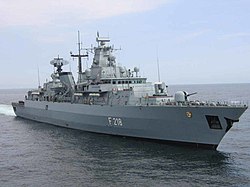F123 Brandenburg class

ASW frigates, 139m/4900t, in service since 1994
Einsatzflottille 2, 2. Fregattengeschwader, Wilhelmshaven:
This is a list of frigates currently in service with the German Navy.

ASW frigates, 139m/4900t, in service since 1994
Einsatzflottille 2, 2. Fregattengeschwader, Wilhelmshaven:

AAW frigates, 143m/5690t, in service since 2004
Einsatzflottille 2, 2. Fregattengeschwader, Wilhelmshaven:
4 Multi-purpose frigates, optimized for long expeditionary peacemaking/peacekeeping missions, 149,5m/ 7200t, 4 planned to replace the F122 Bremen class
